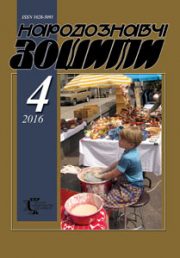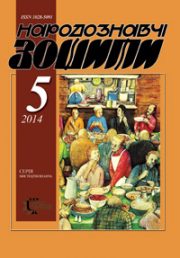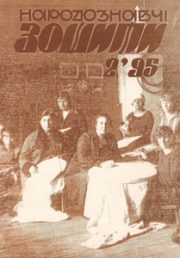The Ethnology Notebooks. 2024. № 2 (182), 375—387
UDK [398.3/.4:2-853]:643:692.4:591.521](=1:100)
DOI https://doi.org/10.15407/nz2025.02.375
ANIMALS ON THE ROOF OF A BUILDING AS PROGNOSTICS IN THE BELIEFS OF THE PEOPLES OF THE WORLD
RAKHNO Kostyantyn
- ORCID ID: https://orcid.org/0000-0002-0973-3919
- Doctor of History, Associate Professor, Leading Researcher
- of the National Museum of
- Ukrainian Pottery in Opishne,
- 102, Partyzanska Str., 38164, Opishne, Ukraine,
- Contacts: e-mail: krakhno@ukr.net
Abstract. Traditional folk culture has such an important function as a prognostic action, which is usually based on intentional knowledge, and in some cases on the interpretation of signs or phenomena received from the outside that require interpretation. Such signs can be «good» or «evil», their interpretation depend on the person and traditional culture. The purpose of the article is to explore the idea of the appearance of animals on the roof of a house as a prediction of the future among different peoples of the world. The object of the research is ethnographically recorded signs, the prognostic nature of which is associated with animals, reptiles, insects and consists in their stay on the roof and behavior there. Traditional folk culture has the necessary set of tools for interpreting these positive or negative signals and signs that have been accumulated and developed by the ethnos over many millennia. The study of signs and beliefs of the peoples of the world regarding animals on the roof is on the periphery of scientific research and is limited to a small number of articles. These beliefs are obviously echoes of ancient archaic ideas about the structure of the world, which must be interpreted and interpreted in accordance with the ideas and previous experience. The methodological basis of the study is a comparative-historical methodological toolkit.
The basis of the work are ethnographic materials related to the perception of the roof in traditional culture. The results of the research are that beliefs regarding the appearance of a particular animal on the roof are characterized by prognostic ambiguity. Since being on the roof was atypical for them, the vast majority of prophecies were ominous. The interpretation of signs regarding animals on the roof of a house in the tradition of the peoples of the world was based on the nature of the behavior of mammals, birds and insects, which were considered carriers of certain information and had signs that were interpreted as warnings, advice, in some cases – prohibitions or permissions, allowing a person to develop a further line or model of behavior. Such signs usually required an observer who could help in their interpretation, and this observer did not necessarily have to be an active participant in the observation, like the ancient haruspices priests. All of them were remnants of ancient beliefs and magical practices. In addition, some living creatures that appeared on the roof were attributed the ability to directly influence certain events.
Keywords: customs, beliefs, rituals, folk religiosity, roof, mythology, traditional culture.
Received 11.03.2025
REFERENCES
- Kaindl, R.F. (1900). Contributions to the Ethnology of the Eastern Carpathian Region. Journal of Austrian Ethnology (Vol. VI, pp. 226—248) [in German].
- Petronius, Arbiter, & Strelnikova, I.P. (1991). Satyricon. Apuleius. Metamorphoses. Moscow: Pravda [in Russian].
- Rose, H.J. (1922). Asinus in Tegulis. Folklore, 1 (Vol. 33, pp. 34—56).
- Solovyova, A.A. (2010). Bone Soul: Demonological Semantics of the Skull and Bone in Chinese and Mongolian Folklore. China and Its Environs: Mythology, Folklore, Literature. On the 75th Anniversary of Academician B.L. Riftin (Pp. 184—212). Moscow: Russian State University for the Humanities [in Russian].
- Potapov, L.P. (1969). Essays on the Everyday Life of the Tuvans. Moscow: Nauka [in Russian].
- Lvova, E.L., Oktyabrskaya, I.V., & Sagalaev, A.M. (1988). Traditional Worldview of the Turks of Southern Siberia. Space and Time. The World of Things. Novosibirsk: Nauka [in Russian]
- Titus, Livius, Gasparov, M.L., Knabe, G.S., & Smirin, V.M. (1993). History of Rome from the Foundation of the City (Vol. III). Moscow: Nauka [in Russian].
- Titus, Livius, Gasparov, M.L., Knabe, G.S., & Smirin, V.M. (1991). Titus Livius. History of Rome from the Foundation of the City (Vol. II). Moscow: Nauka [in Russian].
- Hedayat, S. (1958). Neyrangistan. Near Eastern Ethnographic Collection (Vol. I, pp. 259—336). Moscow: Publishing House of the USSR Academy of Sciences [in Russian].
- Ploshchuk, G.I., & Bolshakova, N.V. (Ed.). (2021). Mythological Stories of the Pskov-Belarusian Borderland: a Monograph: in 2 parts (Part 1: Texts. Comments. Research. Audio Appendix). Pskov: LOGOS [in Russian].
- Rothenbach, J.E. (1876). Folklore from the Canton of Bern. Local Legends and Statutes of Superstitions. Zurich: Cäsar Schmidt Publishers [in German].
- Fischer, H. (1791). The Book of Superstition. Leipzig: Schwickert Publishers [in German].
- Crooke, W. (1918). The House in India from the Point of View of Sociology and Folklore. Folklore, 2 (Vol. 29, pp. 113—145).
- Thurston, Edgar. (1912). Omens and Superstitions in Southern India. New York: McBride, Nast & Company.
- Crooke, W. (1894). An Introduction to the Popular Religion and Folklore of Northern India. Allahabad: Printed at the Government Press, North- Western Provinces and Oudth.
- MacDonald, J. (1891). Manners, Customs, Superstitions, and Religions of South African Tribes. The Journal of the Anthropological Institute of Great Britain and Ireland (Vol. 20, pp. 113—140).
- Henry, A. (1903). The Lolos and Other Tribes of Western China. The Journal of the Anthropological Institute of Great Britain and Ireland (Vol. 33, pp. 96—107).
- Ubushieva, D.V. (2022). Kalmyk Handwritten Ritual Book of «Bad Omens» in the Recording of I.I. Popov. Bulletin of the Kalmyk Scientific Center of the RAS, 1, 119—133 [in Russian].
- Elworthy, F.T. (1895). The Evil Eye: An Account of This Ancient & Widespread Superstition. London: John Murray.
- Frazer, J.G. (1911). The Golden Bough: A Study in Magic and Religion (Part III: The Dying God). London: MacMillan and Co., Limited.
- Khalidova, M.R. (1984). Mythological Images in the Oral Prose of the Peoples of Dagestan. Mythology of the Peoples of Dagestan (Pp. 99—118). Makhachkala: Printing House of the Dagestan Branch of the USSR Academy of Sciences [in Russian].
- Hutton, J.H. (1923). With Reference to Three Points Raised by Certain Passages in Folk-Lore. Folk-Lore, 3 (Vol. 34, pp. 158—160).
- Hutton, J.H. (1922). Carved Monoliths at Dimapur and an Angami Naga Ceremony. The Journal of the Royal Anthropological Institute of Great Britain and Ireland (Vol. 52, part 1, pp. 55—70).
- Hardwick, Ch. (1872). Traditions, Superstitions, and Folk-Lore, (chiefly Lancashire and the North of England: Their Affinity to Others in Widely-Distributed Localities; Their Eastern Origin and Mythical Significance. Manchester and London: A. Ireland & Co., Simpkin, Marshall & Co.
- Frazer, J.G. (1913). The Golden Bough: A Study in Magic and Religion (Part VI: The Scapegoat). London: MacMillan and Co., Limited.
- Fuhrmann, E. (1922). The Animal in Religion. Munich:Publishing Houseof Georg Müller [in German].
- Kryvonis, Vitaliy (2020). Elder Edda. Kyiv: Zhupansky Publishing House [in Ukrainian].
- Rohrich, L. (1951). Dog, Horse, Toad, Snake and Dog as Symbolic Leading Figures in Folk Belief and Legend. Journal for Religious and Intellectual History, 3, 69—76 [in German].
- Eliade, M. (1999). Essays on Comparative Religion. Moscow: Ladomir [in Russian].
- Teutsch, J. (1907). Some of the Superstitions of the Romanians. Proceedings of the Anthropological Society in Vienna (yearbook 1906—1907, pp. 11—16). Vienna: self-published by the Anthropological Society [in German].
- Zlatkovskaya, T.D. (1974). Elements of Thracian Culture in Traditional Fine Arts and Folklore of the Moldavians. Soviet Ethnography, 6, 25—40 [in Russian].
- Zlatkovskaya, T.D. (1977). Some Old Balkan Elements in the Folklore and Ethnography of the Southern Slavs and Eastern Romances. Ethnic History and Folklore (Pp. 185—202). Moscow: Nauka [in Russian].
- Lawrence, R.M. (1898). The Magic of the Horse-Shoe with Other Folk-Lore Notes. Boston and New York: Houghton, Mifflin and Company.
- Leland, Ch.G. (1892). Etruscan Roman Remains in Popular Tradition. London: T. Fisher Unwin.
- Romanov, Ye.R. (1912). Belarusian Collection. Issue eight: Everyday Life of a Belarusian. Vilna: A.G. Syrkin printing house [in Russian]
- (1893). Easter. From the collections sent to the Czech People. Czech People (Vol.II, pp. 598—612, 697—706) [in Czech].
- (1895). Easter. From the collections sent to the Czech People. Czech People (Vol.IV, pp. 322—337) [in Czech].
- Moderndorfer, V. (1948). Beliefs, Views and Customs of the Slovenes: (ethnographic Materials). Second book: Holidays. Celje: Printing House of the Society of St. Mohor [in Slovenian].
- Moderndorfer, V. (1964). Folk Medicine among the Slovenes. Volksmedizin bei den Slowenen. Ljubljana: Slovenian Academy of Sciences and Arts [in Slovenian].
- Urbanczyk, St. (1947). The Religion of the Pagan Slavs.Krakow: Slavic Jagiellonian University Studium Publishing House [in Polish].
- Knezevic, S. (1960). The Image of the Snake in Southern Slavic Folk Art and Tradition. Bulletin of the Ethnographic Museum in Belgrade (Book XXII—XXIII, pp. 57—97). Belgrade: Edition of the Ethnographic Museum in Belgrade [in Serbian].
- Benovska-Sabkova, M. (1992). The Dragon in Bulgarian Folklore. Sofia: Publishing House of the Bulgarian Academy of Sciences [in Bulgarian].
- Karaketov, M.D. (1995). From the Traditional Ritual and Cult Life of the Karachays. Moscow: Nauka [in Russian].
- Chibirov, L.A. (2008). Traditional Spiritual Culture of the Ossetians. Moscow: Russian Political Encyclopedia (ROSSPEN) [in Russian].
- Seferbekov, R.I. (2000). Traditional Religious Beliefs of the Tabasarans (Gods and Demons; Beliefs Associated with Animals). Makhachkala: Institute of History, Archaeology and Ethnography of the Dagestan Scientific Center of the Russian Academy of Sciences [in Russian].
- Khalilov, Kh.M. (1984). Reflections of Pagan Ideas in the Rituals and Folklore of the Laks. Mythology of the Peoples of Dagestan (Pp. 63—81). Makhachkala: Printing House of the Dagestan Branch of the Academy of Sciences of the USSR [in Russian].
- Anisimov, I. (1888). Caucasian Highland Jews. Moscow: printing house of E.G. Potapov [in Russian].
- Avshalumova, N.Kh. (1992). Mythological Images in the Oral Creativity of the Tats. Religion and Atheism: History and Modernity (Pp. 111—123). Makhachkala: Publishing House of Dagestan State University [in Russian].
- Avshalumova, N. (1993). Pagan Customs, Rites, and Holidays Among the Tats-Judaists of Dagestan. Tats-Judaists (Pp. 89—102). Moscow: N.N. Miklouho-Maclay Institute of Ethnology and Anthropology of the RAS [in Russian].
- Avshalumova, N.Kh. (1995). Pagan Customs, Rites, and Holidays Among the Tats-Judaists of Dagestan. Ethnographic Review, 3, 101—107 [in Russian].
- Haciyev, M. (2009). The Language of Azerbaijani Tats. Historical and Ethnographic Essay on Tats. Baku: Translator.
- Jackson, J.G. (1820). An Account of Timbuctoo and Housa, Territories in the Interior of Africa, by El Hage Abd Salam Shabeeny; with Notes, Critical and Explanatory. To Which is Added, Letters Descriptive of Travels through West and South Barbary, and Across the Mountains of Atlas; also, Fragments, Notes, and Anecdotes; Specimens of the Arabic Epistolary Style. London: printed for Longman, Hurst, Rees, Orme and Brown.
- Westermarck, E. (1926). Ritual and Belief in Morocco: in two volumes (Vol. II). London: MacMillan and Co., Limited.
- Westermarck, E. (1920). The Belief in Spirits in Morocco. Åbo: Akademi Åbo.
- Makilam. (2007). The Magical Life of Berber Women in Kabylia. New York: Peter Lang Publishing, Inc.
- Wirth, H. (1931—1936). The Holy Original Scripture of Humanity (Vol. I: Text and Vol. II: Picture Atlas. Symbolic Historical Investigations on Both Sides of the North Atlantic). Leipzig: Published by Koehler & Amelang [in German].
- Chizhikova, L.N. (1970). Architectural Decorations of a Russian Peasant Dwelling. The Russians. Historical and Ethnographic Atlas. From the History of Russian National Housing and Costume (Decoration of Peasant Houses and Clothing). The Mid19th — the Early 20th Century (Pp. 7—61). Moscow: Nauka [in Russian].
- Krinichnaya, N.A. (2001). Russian Folk Mythological Prose. Origins and Polysemanticism of Images: in three volumes (Vol. 1: Tales, Stories, Legends, Beliefs about Spirits-«Masters». St. Petersburg: Nauka [in Russian].
- Perls, H. (1937). The Serpent in the Beliefs of the Polish People. Lviv: Published by the Scientific Printing House [in Polish].
- Schwenk, K. (1851). The Symbols of the Ancient Peoples. Frankfurt am Main: J.D. Sauerländer’sPublishing House [in German].
- Kohlbrugge, J.H.F. (1926). Animal and Human Faces as Defensive Magic. Bonn: Kurt Schroeder Publishing House [in German].
- Seligmann, S. (1910). The Evil Eye and Related Things: a Contribution to the History of Superstition of All Times and Peoples (Vol. 2). Berlin: Hermann Barsdorf Publishing House [in German].
- Terence, Artyushkov, A., & Yarkho, V. (1985). Comedies. Moscow: Khudozhestvennaya literatura [in Russian].
- Klinger, V. (1911). The Animal in Ancient and Modern Superstition. Kyiv: Printing House of the Imperial University of St. Vladimir; JSC Printing and Publishing House of N.T. Korchak-Novitsky [in Russian].
- Daniels, C.L.M., & Stevens, Ch. McCl. (1903). Encyclopaedia of Superstitions, Folklore, and the Occult Sciences of the World: A Comprehensive Library of Human Belief and Practice in the Mysteries of Life. Milwaukee: J.H. Yewdale & Sons Company.
- Stern, B. (1903). Medicine, Superstition and Sexual Life in Turkey. Berlin: Publishing House of H. Barsdorf [in German].
- Maksimov, S.V. (1903). Unclean, Unknown and Cross Power. Saint Petersburg: partnership of R. Golike and A. Vilborg [in Russian].
- Black, W.G. (1883). The Hare in Folk-Lore. The Folk-Lore Journal, 3 (Vol. 1, pp. 84—90).
- Sweeting, W.D. (1886). Folk-Lore of the Hare. Northamptonshire Notes & Queries: A Quarterly Journal (Pp. 161—162). Northampton: the Dryden Press, Taylor & Son
- D., E.S. (1867). Folk Lore: the Hare. Notes and Queries, Third series, 11, 134—135.
- Philippson, E.A. (1929). Germanic Paganism Among the Anglo-Saxons. Leipzig: Verlag von Bernhard Tauchnitz [in German].
- Henderson, W. (1866). Notes on the Folk-Lore of the Northern Counties of England and the Borders. London: W. Satchell, Peyton and Co.
- Owen, E. (1896). Welsh Folk-Lore: a Collection of the Folk-Tales and Legends of North Wales. Oswestry and Whexham: Printed and Published by Woodall, Minshall, and Co.






